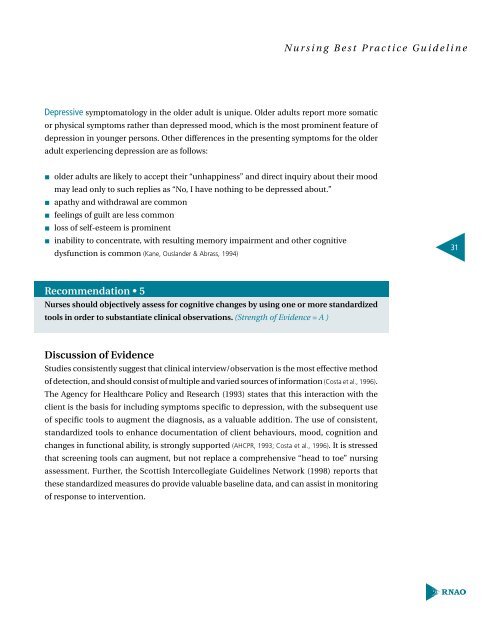Screening for Delirium, Dementia and Depression in Older Adults
Screening for Delirium, Dementia and Depression in Older Adults
Screening for Delirium, Dementia and Depression in Older Adults
- No tags were found...
You also want an ePaper? Increase the reach of your titles
YUMPU automatically turns print PDFs into web optimized ePapers that Google loves.
Nurs<strong>in</strong>g Best Practice Guidel<strong>in</strong>eDepressive symptomatology <strong>in</strong> the older adult is unique. <strong>Older</strong> adults report more somaticor physical symptoms rather than depressed mood, which is the most prom<strong>in</strong>ent feature ofdepression <strong>in</strong> younger persons. Other differences <strong>in</strong> the present<strong>in</strong>g symptoms <strong>for</strong> the olderadult experienc<strong>in</strong>g depression are as follows: older adults are likely to accept their “unhapp<strong>in</strong>ess” <strong>and</strong> direct <strong>in</strong>quiry about their moodmay lead only to such replies as “No, I have noth<strong>in</strong>g to be depressed about.” apathy <strong>and</strong> withdrawal are common feel<strong>in</strong>gs of guilt are less common loss of self-esteem is prom<strong>in</strong>ent <strong>in</strong>ability to concentrate, with result<strong>in</strong>g memory impairment <strong>and</strong> other cognitivedysfunction is common (Kane, Ousl<strong>and</strong>er & Abrass, 1994)31Recommendation • 5Nurses should objectively assess <strong>for</strong> cognitive changes by us<strong>in</strong>g one or more st<strong>and</strong>ardizedtools <strong>in</strong> order to substantiate cl<strong>in</strong>ical observations. (Strength of Evidence = A )Discussion of EvidenceStudies consistently suggest that cl<strong>in</strong>ical <strong>in</strong>terview/observation is the most effective methodof detection, <strong>and</strong> should consist of multiple <strong>and</strong> varied sources of <strong>in</strong><strong>for</strong>mation (Costa et al., 1996).The Agency <strong>for</strong> Healthcare Policy <strong>and</strong> Research (1993) states that this <strong>in</strong>teraction with theclient is the basis <strong>for</strong> <strong>in</strong>clud<strong>in</strong>g symptoms specific to depression, with the subsequent useof specific tools to augment the diagnosis, as a valuable addition. The use of consistent,st<strong>and</strong>ardized tools to enhance documentation of client behaviours, mood, cognition <strong>and</strong>changes <strong>in</strong> functional ability, is strongly supported (AHCPR, 1993; Costa et al., 1996). It is stressedthat screen<strong>in</strong>g tools can augment, but not replace a comprehensive “head to toe” nurs<strong>in</strong>gassessment. Further, the Scottish Intercollegiate Guidel<strong>in</strong>es Network (1998) reports thatthese st<strong>and</strong>ardized measures do provide valuable basel<strong>in</strong>e data, <strong>and</strong> can assist <strong>in</strong> monitor<strong>in</strong>gof response to <strong>in</strong>tervention.
















